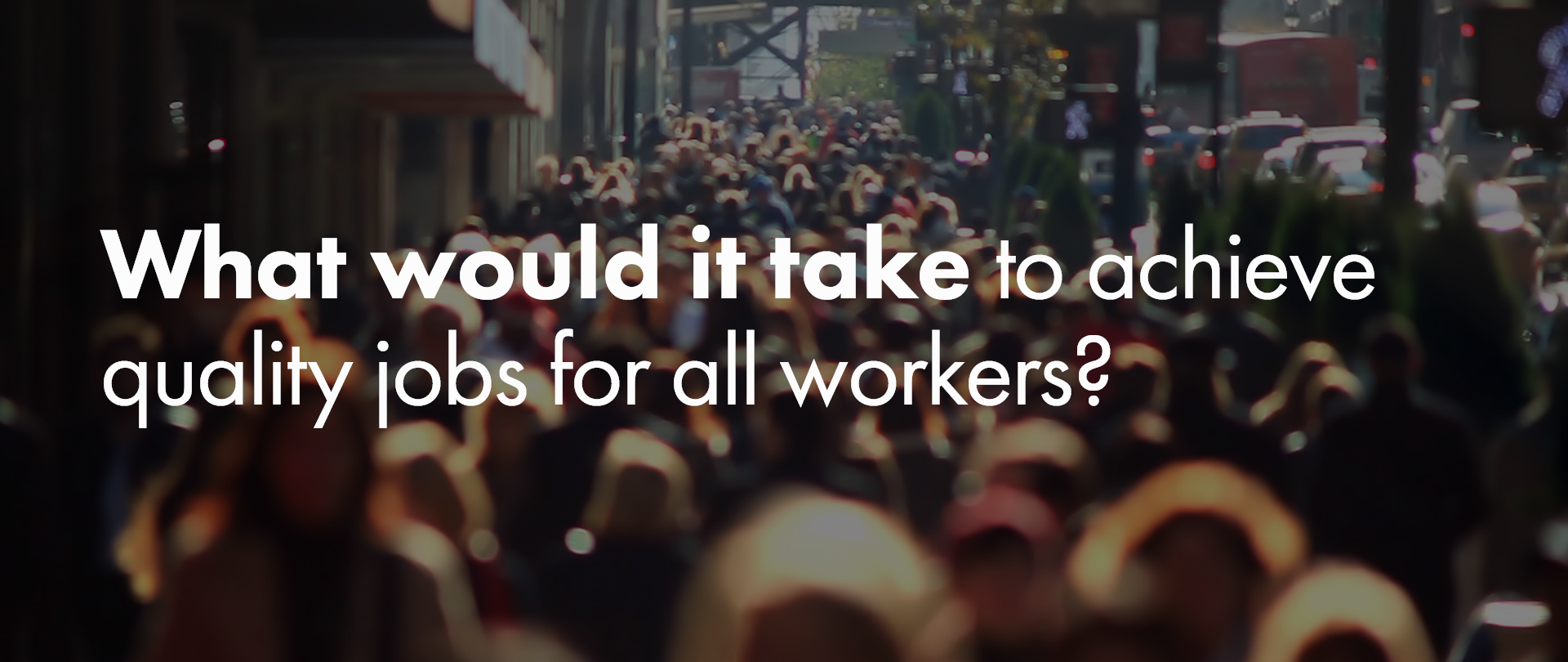
The nature and organization of work are changing rapidly and in fundamental ways. New technologies, evolving workforce demographics, shifting global demand, and related transformations in business models leave some workers in a precarious position.
But we can imagine a future in which these far-reaching changes—and responses to them—improve job quality for all workers, while fueling higher productivity for businesses and national economic growth. We envision jobs that enable people to earn family-sustaining wages and gain access to better benefits, especially those that historically have been provided through employment. And we envision safe and healthy work environments where workers’ rights are protected, where they have a voice in decisions about working conditions and wages, and where their input strengthens productivity and innovation.
The challenges are complex and daunting. Advances in technology, automation, and artificial intelligence may eliminate some jobs while creating others. Global competition and new technologies have caused many large employers to restructure their operations through outsourcing, complex supply chains, or franchising. A growing share of people work as temporary employees, as independent contractors, or in “gig” jobs. Although these arrangements offer flexibility, they lack the benefits and legal protections associated with traditional employment relationships. Meanwhile, climate change is causing shifts in the location of some industries and businesses, in global migration of workers, and even in the nature of some kinds of work.
Achieving quality jobs for all will require innovative action from employers, workers, all levels of government, and nonprofits. We see reason for optimism.
Job Quality: Promising Solutions
Employers, industries, workers, and public-sector leaders are exploring solutions for the complex challenges of today’s economy. What follows are five strategies for making sure more 21st-century workers have quality jobs.
Increase effective wages

Photo by Patrick T. Fallon/Bloomberg via Getty Images.
“We’ve invested in wages and benefits so our team members can take care of themselves and their families.”
— Stephanie Lundquist, Chief Human Resources Officer at Target, which has committed to paying its employees at least $15 an hour by the end of 2020.
For the past 30 years, wages have been fairly stagnant for low- and middle-wage workers. Approaches for boosting wages include
- raising the hourly minimum, as has been done in cities like Los Angeles, Minneapolis, Seattle, and Washington, DC, and in states like New York;
- advocacy efforts, like the One Fair Wage campaign sponsored by the Restaurant Opportunities United Centers, that push to increase pay for tipped workers;
- large employers like Amazon, Bank of America, Target, and Walmart voluntarily increasing wages for low-wage workers, creating pressure on other industry employers to follow suit; and
- other employers adopting practices like the Good Jobs Strategy that are proving profitable while offering fair wages and predictable schedules.
Another approach is to broaden public programs that augment wages for targeted workers, such as the federal earned income tax credit, which supplements low earnings for millions of workers with children.
- More than 25 states and several local areas provide their own earned income tax credits.
- Some places, including California and Washington, DC, have expanded the credit to workers without children, and demonstrations elsewhere are testing the effects of similar expansions.
In addition, states like New York strengthen workers’ influence and engagement through state wage boards, which typically include representatives from labor, management, and the public. Such boards can issue orders that the governor can consider in setting minimum wages or other labor rules for industries, occupations, or regions.
Improve access to benefits
Alia allows people to provide benefits, like paid time off and insurance, to the person who cleans their home.
As the nature of work and traditional employment relationships change, a growing number of people work but don’t receive health insurance, retirement plans, and other benefits through their jobs. Solutions that give more workers access to benefits include
- Alia, which allows housecleaners’ clients to contribute to a benefits program that provides access to paid time off and insurance protections;
- The Black Car Fund, a workers compensation benefit program for for-hire drivers in New York City;
- Vermont’s Multiple Employer Plans, where different employers pay into retirement benefits for people with several jobs or part-time jobs;
- a pilot program for portable benefits for independent workers proposed by Senator Mark Warner and Congresswoman Suzan DelBene; and
- state laws requiring employers in Washington, DC, and nine states to provide paid sick leave.
Another approach, led by the American Sustainable Business Council, encourages employers to take the “high road” by offering more benefits and better working conditions. Among the organizations embracing this solution are
- Etsy, which offers six months of paid family leave;
- Starbucks, which provides free college tuition; and
- Harvard University, which pays its contracted workers (e.g., those who provide janitorial services) the same as if they were university employees.
Strengthen worker protections and standards

Photo by Frédéric Soltan/Corbis via Getty Images.
Several global apparel companies report where their clothing and footwear are made and under what conditions. Advocates say such transparency helps promote corporate accountability for workers’ rights.
Job quality isn’t defined only by wages and benefits. It’s also shaped by practices that protect workers’ health and safety. Some industries and employers are taking more responsibility for the practices of companies in their supply chain, to which they outsource work or franchisees. For instance,
- a growing number of apparel companies like Levi Strauss, Nike, and Patagonia signed on to the Transparency Pledge, agreeing to report their supply chain; and
- Subway entered into a voluntary agreement to raise compliance among its franchisees.
State and local governments are experimenting with strategies to improve labor standards and protections, including
- New York City’s passage of the Freelance Isn’t Free Act, the only law of its kind to protect the city’s independent workers from wage violations and retaliation;
- California’s adoption of the “ABC test,” which requires employers to presume their workers are employees unless they can prove, using three factors, that workers are running their own business; and
- the Illinois Day and Temporary Labor Services Act, which covers more than 800,000 temporary employees and requires staffing agencies to provide workers notice in writing of terms such as the wage rate and schedule as well as the length and location of assignments.
Boost worker power and engagement
“Workers are organizing online at sites like coworker.org to fight for new protections. ... We’ve got to find new ways that they can express solidarity. And that’s where technology can help.”
The decades-long decline in union membership in the US makes it difficult for some types of workers to organize in traditional ways, and new workplace arrangements are altering how employees collectively bargain. Examples include
- New York City’s Independent Drivers Guild, an affiliate of the Machinists Union representing Lyft and Uber drivers;
- coworker.org, which allows workers to create petitions and start campaigns to change workplace policies; and
- the Fair Food Program, a partnership among farmers, farmworkers, and retail food companies that ensures “humane wages and working conditions for the workers who pick fruits and vegetables on participating farms.”
Workers’ engagement efforts can also extend beyond the employees of one company or one place, like local wage boards (see above) or the Fight for $15 (backed by the Service Employees International Union) to raise the minimum wage in cities and states. And many successful companies that rank highly as good places to work provide employees opportunities to invest in the companies through discounted stock or employee ownership options.
Create flexible public employment strategies
In response to inevitable shifts that come with economic downturns or when jobs are displaced by industrial or technological changes, politicians, researchers, policymakers, and social entrepreneurs are advocating for a major expansion of publicly subsidized jobs, including
- proposals introduced in Congress for a federal job guarantee program that offers a decent-paying job to anyone who needs it, and
- subsidizing jobs directly in the public, nonprofit, or private sector during periods of high unemployment.
Job Quality: Knowledge Priorities
As leaders in business, government, philanthropy, and advocacy explore solutions for improving job quality, they are looking for reliable and up-to-date evidence to design, implement, and weigh costs and trade-offs. Below, we identify areas where new data and analytic tools would help changemakers advance the bold ideas they’re pursuing.
Identify ways technology can improve job quality
“We don’t yet have sufficient data to map jobs to the skills businesses need in their workforce.... We need to integrate public data with proprietary business data to better understand current labor market demand and examine how these data change over time.”
As technology rapidly evolves, it’s still unclear how these changes will affect work in the future or what they will mean for different employers and workers. Employers and advocates who want to harness new technologies to improve job quality and productivity and advance equality of opportunity need more information about how technology is applied in different sectors and occupations. They can use that information to better identify and develop strategies for technology use that are good for workers and businesses. Examples include restructuring jobs to reduce workplace injuries or allowing more complex but flexible scheduling for workers. Policymakers, employers, worker advocates, and technology experts can collaborate to build this knowledge by
- analyzing how technology is reshaping jobs in particular sectors, such as logistics and warehouse work, transportation, or direct patient health care, to uncover opportunities for improving job quality; and
- developing shared frameworks and metrics to assess positive and negative impacts of technology on job quality.
A specific application of this approach would convene policymakers, employers, worker and civil rights advocates, and technology experts to explore how artificial intelligence is shaping how employers recruit, hire, and promote workers and to identify solutions to concerns about fairness, accountability, and transparency.
Estimate impacts of new benefits and standards
“Developing a first-of-its-kind scheme will involve business impacts, implications for worker and consumer protection, complexity in market design and regulatory framework, and the need for prudential standards.”
Federal and state policymakers need consistent outcome metrics they can apply to assess and compare proposals for new benefit mandates and workplace regulations. Understanding how competing proposals would affect workers (in aggregate and across types of workers and employers) would enable them to weigh trade-offs as they consider alternative strategies. This can be achieved by
- developing metrics to capture intended outcomes—such as greater child care stability or lower stress at work—of new benefit or regulatory policies;
- using microsimulation modeling to estimate the distributional impacts of proposed new benefit and workplace standard policies; and
- analyzing the impact on workers and employers of new local and state job quality policies as they are enacted.
Monitor standards and compliance
“The best way to learn about worker voice is through worker centers. Once we’re educated about what to do collectively, data can come forth.”
Employers, worker advocates, and government regulators need to be able to track trends in workplace issues and access timely information about workplace standards by industry sector and geographic area to advance effective practices. Because standards and their enforcement vary widely across industries and jurisdictions, information about their effectiveness is fragmented and inaccessible. A program of knowledge-building to fill this gap would include
- developing integrated indicators of workplace standards at the state and industry level that account for the full range of workplace protections;
- conducting behavioral experiments to analyze how different workplaces enforce their standards and to test voluntary and regulatory interventions to improve compliance; and
- documenting sectors with rigorous voluntary standards and comparing them with standards set by federal or state agencies to better assess the incentives and barriers of voluntary and government standards.
Catalog efforts to expand worker engagement
To increase employees’ participation in job quality improvements, employers and worker organizations need to know more about emerging strategies to engage workers, including the challenges that arise, lessons learned, and ways to expand effective practices. With more evidence on leading models of employee participation, workplace flexibility, and collective advocacy, organizations could better understand their options and could adapt engagement strategies for addressing workplace culture and policy issues, including health insurance, safety, leave, and career development. Stakeholders can build this knowledge by
- developing case studies on various engagement approaches to understand the factors that influence success in some workplaces but not in others;
- examining different models of organizing on behalf of independent contractors to determine whether promising efforts can be replicated for different sectors of contractors;
- analyzing new forms of union recruitment outside traditional dues-paying membership models, such as petition-based efforts; and
- surveying and documenting workers’ views about traditional and new models of engagement.
Estimate impact and cost of job guarantee proposals
Policymakers considering guaranteed jobs programs need to know how different designs can achieve specific goals. Would a guaranteed jobs program supplement, not displace, job creation? Could it expand quickly in an economic downturn? Would it help workers who’ve lost jobs to automation and need new skills? Policymakers also need more information on how specific program features influence outcomes and costs. Achieving this would require a knowledge-building program that includes
- microsimulation modeling to provide consistent and reliable estimates of competing job guarantee proposals so federal and state legislators and advocates can compare the costs and benefits and populations affected, and scale different approaches; and
- rigorous demonstrations, such as randomized controlled trial experiments, to test the costs, feasibility, and impacts of selected job guarantee models.
Gather new data on nonstandard work arrangements
Nonstandard work arrangements, including independent contractors, temporary agency workers, and freelance, platform, or “gig” workers, are the focus of discussions about the future of work and job quality. But the information changemakers need to assess and address these issues—like whether to develop alternative benefit programs or modify regulations on the classification of employees as contractors—is limited. To target solutions for improving job quality in nonstandard work, legislators and advocates need to know more about the number and characteristics of these workers and why workers and firms choose these arrangements. Achieving this calls for
- improving the regularity and accuracy of federal surveys of the “contingent” workforce to build reliable statistics on nonstandard work arrangements;
- determining how to improve the definitions of different nontraditional work arrangements and how best to communicate these definitions when surveying workers; and
- conducting in-depth interviews and focus groups to gather data on why workers choose these arrangements, perspectives on positive and negative aspects of the work, and what could improve job quality.
Based on the Job Quality Catalyst Brief, written by Pamela Loprest, Demetra Nightingale, Jenny R. Yang, and K. Steven Brown.

